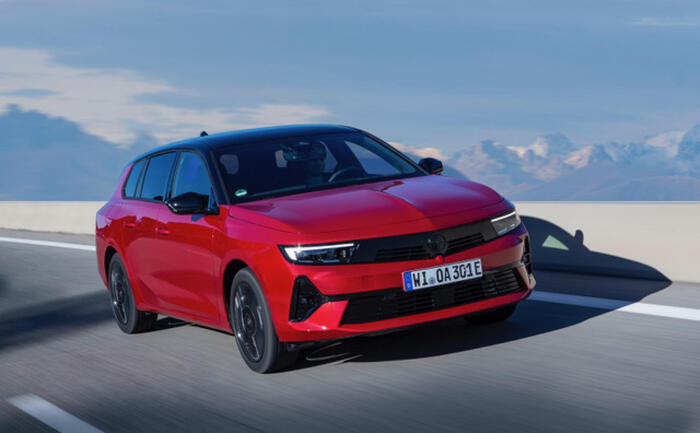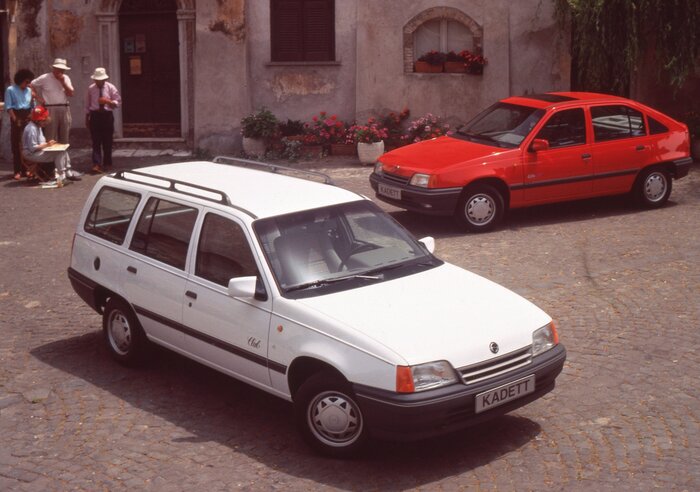The new Opel Astra Sports Tourer: Lots of space, low fuel consumption
Created: 06/29/2022Updated: 06/29/2022 15:04
By: Rudolf Boegel
Hardly any difference recognizable.
On the left the Opel Astra Sports Tourer, on the right the five-door sedan.
© Axel Wierdemann / Opel
The new Opel Astra is finally available as a station wagon.
The Sports Tourer wants to be a load master and, as a plug-in hybrid, also a fuel saver.
The first driving test.
Caravans have a long tradition at Opel; since 2010 they have been called Sports Tourers.
The compact is now also available as a station wagon - and right from the start as a plug-in hybrid.
Practical, generously good - loading is really child's play, but one detail is missing.
"Hey, he looks good!" The Frankfurt parcel driver almost lost control when he saw
the new Opel Astra
.
“May I sit down.” “Really chic,” is his verdict here, too, “but I'll wait until the station wagon arrives before I buy it.
I need something practical.” That was a few months ago when the limousine was presented and is an example of what the sales documents support.
Two-thirds of Astra sales are station wagons, and Opel also
sports tourers
called.
And now there is the new example, meanwhile in the eleventh generation.
If you count all the Kadett models, you come to around 25 million units sold.
And then the history of the compact car even goes back to 1936.
Station wagons have been around for a long time in the 160 years of Opel.
Legends include the Opel Rekord Caravan from 1953 or the Kadett A Caravan 1000 from 1963. And people in Rüsselsheim still feel committed to this tradition today.
The station wagons used to be called caravans and were often craftsmen's cars.
Since 2010, Opel has renamed it Sports Tourer.
© Opel
Station wagon exceeds sedan by a ruler length
With the new Astra Sport Tourer they wanted to make the load champion in its class.
No more no less.
The test drive
will show
whether this was successful .
It's a pity that we didn't meet the parcel driver by chance.
We would be only too happy to ask him if he sees the difference between a limousine and a station wagon.
It's not that easy - quite apart from the characteristic side view, which is striking because the
station wagon is 27 centimeters longer
.
But from the front, the Sports Tourer looks the same as the five-door.
Also from behind.
More identical parts make production cheaper.
By the way, there are more detailed driving reports here.
The Opel Astra Sports Tourer is definitely a Ladmeister.
It offers plenty of space, has a large flap and a flat loading floor.
© Opel
Inviting people into the Opel Astra Sports Tourer is inviting
However, if you compare the rear closely, you will notice an important detail after a long look: the
license plate
was integrated into the tailgate of the station wagon, directly under the
Opel logo
.
On the sedan, the car sign is at the bottom of the apron.
Advantage
station wagon
: because this allowed the engineers to make the tailgate higher.
1.03 meters high, 1.03 meters wide, this is an opening even for bulky objects.
In the Astra, loading really is child's play.
Especially since the floor is flat as a board, even if you fold down the seats.
And another piece of good news: there are almost no annoying loading sills.
Even with the
PHEV
, which still has to accommodate an additional battery, the space available is decent.
516 - 1,553 liters fit in.
Speaking of the folded seat.
Who does not know that?
Where to put the strip with the trunk cover?
The Opelians have a patent solution for this as well.
It is simply stowed in the double loading floor, there is even a corresponding recess in the plastic.
The Astra is also a master loader when it comes to the space available for passengers.
The colleague on the driver's seat measures 1.92 meters.
But no problem.
He can push the seat even further back than necessary.
There would even be room for 2.10 meter giants.
also read
Masks in the first aid kit mandatory?
What drivers should know about it
Polishing headlights: The "repair" can cost TÜV
The cockpit of the Opel Astra is sober and modern.
The continuous screen landscape is called Pure Panel.
There are delivery problems here.
© Opel
Be careful when ordering, there could be trouble here
The
interior of the Astra
is quite chic, even if a lot of plastic has been used.
However, fine mesh structures and imitation leather give the interior a cool, tidy look.
The
center console
offers many high-maintenance piano lacquer surfaces.
The Pure Panel Pro display, which merges the infotainment screen and speedometer display into one unit, is also nice.
Pretty premium, like BMW or Mercedes.
However, with one big restriction: the screen landscape is available in real glass and should probably also be part of the standard equipment for the Astra Sports Tourer.
However, there are delivery problems - and the alternative, the plastic panel, is not really nice.
Our tip: Address the problem with the retailer before ordering so that you are not too disappointed afterwards.
And something else from the complaining corner: why there are no hooks for jackets or jackets - one can only wonder.
After all, the
Sports Tourer
is a real field service car.
IntelliLux LED Pixel Light is what Opel calls the intelligent light that optimally illuminates the road without dazzling oncoming traffic.
© Opel
Opel Astra Sports Tourer: Is the plug-in hybrid really that economical?
Oh yes - the Astra Sports Tourer can of course also drive.
Conventionally with
petrol
or
diesel.
Or just as modern as a plug-in hybrid (PHEV).
It offers the best performance with 180 hp and 360 Nm of torque, but is it the best choice?
The first test laps show: the two
engines
work together properly while in gliding mode.
As soon as power is requested, the transmission allows itself a short commemorative second, then the engine howls, and finally it goes forward.
This drive is already known from the Stellantis universe.
It doesn't necessarily feel nice, but it's effective.
At the end of our approximately 160-kilometer test drive, we consumed 4.1 liters of petrol.
The system does not display the power requirement, but the battery is completely empty.
That means we probably used around 14 kilowatt hours, which at a low price of 29 cents costs another 4.20 euros per 100 kilometers.
Okay - but not necessarily cheap when you add it all up.
A carefully driven diesel can even be less than that, even with today's fuel prices.
The Opel Astra and its many predecessors.
If you add the Kadett, the compact car is now in its eleventh generation.
© Opel
And that's what the different Astra variants cost
When it comes to the
selling price
, the plug-in hybrid is definitely at the top.
Even if you deduct the environmental bonus, it still costs around 32,500 euros more than the 130 hp diesel (31,700 euros).
The 110 hp petrol engine is unrivalled.
The entry-level variant costs only 27,750 euros.
If the state subsidies for plug-in hybrids are overturned, and this is to be expected, then the PHEV will become a bit less profitable.
It doesn't help much that Opel is already promising to pay the manufacturer's share of 2,250 euros in 2023.
Specifications Opel Astra Sports Tourer Plug-in Hybrid
combustion engine
Four-cylinder turbo petrol engine
Displacement: 1598 cc
max. power: 110 kW (150 hp) at 6,000
Max. torque: 250 Nm at 1,750 rpm
E-machine:
max. power: 81 kW (110 hp)
maximum torque: 320 Nm
System:
max. power: 133 kW (180 hp)
Max. torque: 360 Nm at 1,750 rpm
Battery: 13.8kWh
Electric range (city traffic): 60 km (70)
Charging time: 2 hours
00 min. with 7.4 kW (optional onboard charger) / wall box
3 hours.
50 min. with 3.7 kW (standard onboard charger) / AC (wall box)
7 hrs
00 min. with 2.3 kW / AC (domestic socket)
Drive: 8-speed automatic, front
0-100km/h: 7.7 seconds
Top: 225 km/h / 135 km/h (electric)
Standard consumption: 1.1 l / 100 km
Electricity consumption: 14.8 kWh
CO2 emissions: 25 g/km
Length / width / height: 4.64 / 1.86 / 1.44 m
Trunk: 516 - 1,553 l
Empty weight / payload: 1717 / 453 kg
Towing capacity (used): 1,400 kg
Price from: 39,750 euros (less environment bonus 32,572 euros)
Rudolph Boegel








